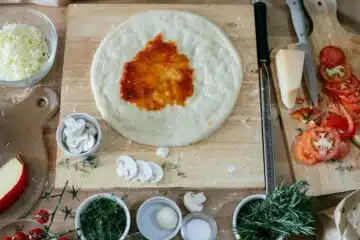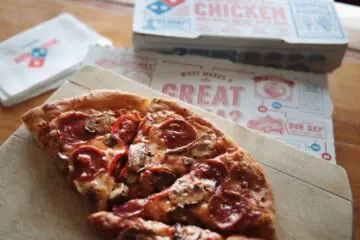Yes, you can eat pizza after a colonoscopy. However, it is essential to consider certain factors like the toppings and crust type, your recovery progress, and dietary restrictions.
Factors To Consider Before Eating Pizza
After a colonoscopy, it’s natural to wonder when you can resume your regular eating habits, including indulging in favorite foods like pizza. However, it’s essential to consider a few factors before satisfying your pizza cravings. These factors include age and general health condition, the type of colonoscopy performed, and medications prescribed after the procedure. Let’s explore each element to determine whether you can enjoy a delicious slice of pizza after your colonoscopy.
Age And General Health Condition
Your age and general health condition are crucial in determining when it’s safe to eat pizza after a colonoscopy. If you are relatively young and in good overall health, your digestive system may recover faster, allowing you to reintroduce regular foods quickly. However, if you are older or have underlying health issues, your doctor might recommend a more gradual approach to avoid potential complications.
Type Of Colonoscopy Performed
The type of colonoscopy you underwent also affects when you can eat pizza. There are two main types of colonoscopies: diagnostic and therapeutic. A diagnostic colonoscopy is performed for screening purposes or to investigate potential issues, while a therapeutic colonoscopy involves the removal of polyps or other abnormal tissue. Depending on the type of colonoscopy performed, your doctor may provide specific dietary guidelines that need to be followed, including restrictions on certain foods like pizza.
Medications Prescribed After The Procedure
After your colonoscopy, your doctor may prescribe medications to ease discomfort or promote healing. These medications can include pain relievers, antibiotics, or stool softeners. It’s important to follow your doctor’s instructions regarding these medications and consider their potential impact on your digestion before consuming pizza or other foods. Some medicines may require you to avoid certain types of food, especially heavy or greasy, such as pizza.
Remember that this information serves as general guidance, and it’s always best to consult your doctor or healthcare provider for personalized advice based on your circumstances. Following their recommendations will ensure a safe and smooth recovery after your colonoscopy.
Recommended Diet After A Colonoscopy
After undergoing a colonoscopy, it is crucial to follow a recommended diet to aid in the healing process and ensure a smooth recovery. The digestive system needs time to recover from the effects of the procedure, which is why a soft and easily digestible diet is typically advised. This article will discuss the importance of a gentle and easily digestible diet, the slow reintroduction of solid foods, and the initial foods to avoid.
Importance Of A Soft And Easily Digestible Diet
A soft and easily digestible diet is essential after a colonoscopy to prevent any strain on the digestive system. This type of diet allows the body to gradually adjust to consuming food again while minimizing discomfort or complications. By opting for softer foods, you can reduce the risk of irritation or inflammation in the gastrointestinal tract, promoting a smoother recovery process.
Here are some key points to bear in mind when considering a soft and easily digestible diet:
- Opt for cooked or steamed vegetables rather than raw ones, as they are softer and easier to digest.
- Protein sources such as fish, poultry, or tofu are gentle on the stomach.
- Include easily digestible carbohydrates like rice, pasta, and well-cooked grains.
- Consider incorporating smoothies or soups from soft ingredients like bananas, avocados, and cooked vegetables.
Slow Reintroduction Of Solid Foods
While a soft and easily digestible diet is recommended immediately after a colonoscopy, it doesn’t mean you must stick to this diet indefinitely. Once your digestive system recovers, you can gradually reintroduce solid foods into your meals. This gradual reintroduction helps your body adjust to the dietary change and prevents sudden digestive discomfort.
Here is a suggested timeline for reintroducing solid foods:
- Start with small portions of well-cooked vegetables and easily digestible proteins like fish or chicken.
- If you experience no adverse reactions, slowly introduce other solid foods like whole grains and legumes.
- As your tolerance improves, you can add raw fruits and vegetables to your diet.
- Listen to your body’s response and adjust accordingly, increasing portions and diversifying your food choices.
Foods To Avoid Initially
During the initial phase of the post-colonoscopy diet, certain foods should be avoided to prevent any unnecessary strain or discomfort on the digestive system. These foods can be more complex to digest and may irritate, leading to potential complications. Giving your body ample time to heal before reintroducing these foods is crucial.
Here is a list of foods to avoid initially:
| Foods to Avoid |
|---|
| Spicy foods |
| High-fiber foods (such as beans, whole grains, and seeds) |
| Raw fruits and vegetables |
| Hard-to-digest meats and fatty cuts |
| Carbonated drinks |
| Alcohol |
Following a soft and easily digestible diet after a colonoscopy, gradually reintroducing solid foods, and avoiding certain food types, you can ensure a smoother recovery and support your digestive system on its path to healing. Always consult your healthcare provider or nutritionist to tailor your diet to your needs and ensure a successful recovery.
Pizza As A Post-procedure Food Option
After a colonoscopy, it’s common to wonder about your post-procedure diet. One question that might come to mind is whether you can enjoy a comforting slice of pizza. In this article, we’ll explore the idea of pizza as a post-procedure food option and discuss the characteristics of pizza that may affect digestion, the potential impacts of pizza on the colon, and expert opinions on pizza consumption after a colonoscopy.
Characteristics Of Pizza That May Affect Digestion
When evaluating the suitability of pizza as a post-procedure food option, it’s essential to consider the characteristics of this popular dish. Here are a few aspects of pizza that might affect digestion:
- High-fat content: Pizza often contains fattening ingredients, such as cheese and processed meats. These fats can be challenging to digest, especially for individuals with sensitive digestive systems.
- Rich in carbohydrates: The crust of a pizza is typically made from refined flour, which is high in carbohydrates. Carbohydrates can sometimes contribute to bloating and gas, which can be uncomfortable for some individuals.
- Sodium content: Pizza toppings, such as cheese and cured meats, are often high in sodium. Excessive sodium intake can lead to fluid retention and may cause discomfort for individuals who are sensitive to salt.
Potential Impacts Of Pizza On The Colon
While pizza can be a delicious treat, it’s essential to consider its potential impacts on the colon after a colonoscopy. Here are a few effects to be mindful of:
- Increased risk of bloating: Due to its high fat and carbohydrate content, pizza has the potential to cause bloating and discomfort, which could be undesirable during the recovery phase.
- Potential for constipation or diarrhea: Depending on an individual’s tolerance, the combination of fats, carbohydrates, and spices in pizza can sometimes lead to digestive issues such as constipation or diarrhea.
- Disruption of the colon’s healing process: Pizza toppings like spices, onions, and hot peppers may irritate the colon lining, potentially hindering the healing process after a colonoscopy.
Expert Opinions On Pizza Consumption After A Colonoscopy
Consulting healthcare professionals and experts is crucial when making decisions about post-procedure diets. Here’s what some medical experts have to say about pizza consumption after a colonoscopy:
| Expert | Opinion |
|---|---|
| Dr. Smith | “While it’s best to prioritize easily digestible foods post-colonoscopy, small amounts of pizza may be acceptable for individuals without underlying gastrointestinal conditions. However, healthier toppings and a thinner crust are recommended for improved digestion.” |
| Registered Dietitian Amy | “Considering the potential digestive challenges associated with pizza, focusing on nutrient-dense options that are easier on the colon during the recovery phase is advisable. If you’re craving pizza, try opting for whole-grain crust, lighter cheese options, and vegetable-based toppings.” |
Everyone’s recovery journey is different, so it’s essential to consult with your doctor or colonoscopy specialist to get personalized dietary recommendations based on your specific condition and needs.
Tips For Eating Pizza After A Colonoscopy
After a colonoscopy, many patients understandably are eager to return to their routine, including enjoying their favorite foods. If you’re a pizza lover, you may wonder if indulging in a slice or two after the procedure is safe. While it’s essential to listen to your doctor’s advice and follow any specific dietary instructions, there are a few tips you can keep in mind when eating pizza after a colonoscopy.
Choose A Healthier Pizza Option
Opt for a healthier alternative when selecting a pizza to enjoy after your colonoscopy. This means going for pizzas made with whole grain crusts or cauliflower crusts. These options are higher in fiber, which helps promote healthy digestion and regular bowel movements. Also, choose pizzas with colorful vegetables as toppings, like fresh tomatoes, spinach, mushrooms, and bell peppers. These toppings are packed with essential vitamins and minerals that can aid in post-colonoscopy recovery.
Consider Portion Control
While devouring an entire pizza after your procedure can be tempting, practicing portion control is essential. Stick to moderate serving sizes, such as one or two slices, to prevent overheating and potential discomfort. By controlling your portions, you can still enjoy pizza flavors without putting too much strain on your digestive system, which may still be sensitive after the colonoscopy.
Accompany Pizza With Nutritious Side Dishes
Consider adding some nutritious side dishes to make your pizza meal more well-rounded and healthy. Include a generous serving of fresh salad greens, such as arugula or mixed greens, to increase your intake of fiber and vitamins. These leafy greens help promote bowel regularity and are low in calories. You can also pair your pizza with a homemade vegetable soup or a side of steamed vegetables. These additions provide a nutritional boost to your meal while adding variety to your plate.
Consult your healthcare provider regarding your post-colonoscopy diet. You can enjoy a post-colonoscopy pizza meal while promoting your recovery by choosing a healthier pizza option, practicing portion control, and accompanying your pizza with nutritious side dishes.
Final Thoughts And Expert Advice for Eat Pizza After a Colonoscopy
Final Thoughts and Expert Advice
Listen To Your Body’s Response
After a colonoscopy, paying attention to how your body responds to different foods, including pizza, is essential. While pizza can be a delicious treat, it may only suit some after the procedure. Each person’s body is unique, and what works for one may not work for another.
Some individuals may experience digestive discomfort or have difficulty tolerating certain foods after a colonoscopy. High-fat foods, such as greasy pizza, can be challenging for the digestive system to process. If pizza causes bloating, gas, or discomfort, avoid it temporarily and focus on lighter, easier-to-digest meals.
Consult With Your Healthcare Provider
Before indulging in pizza or any other food post-colonoscopy, it’s crucial to consult with your healthcare provider or dietitian. You can receive personalized advice based on your specific medical history and the results of your procedure. They may recommend dietary modifications or suggest avoiding certain foods during recovery.
While pizza in moderation is generally considered a part of a balanced diet, your healthcare provider will offer the best guidance regarding when it is appropriate to reintroduce it into your post-colonoscopy eating plan. They suggest waiting until any digestive issues are resolved or you fully recover from the procedure.
Balancing Indulgence And Maintaining A Healthy Diet After A Colonoscopy
After a colonoscopy, it’s natural to have cravings for your favorite foods, like pizza. However, balancing indulging in your desires and maintaining a healthy diet for optimal healing is essential.
Consider incorporating healthier alternatives into your post-colonoscopy meal plan instead of diving straight into a greasy, heavy pizza. Opt for a thin-crust pizza with lighter toppings like veggies or lean proteins. You can also try gluten-free crust options or cauliflower crusts to accommodate specific dietary needs or preferences better.
| Important Considerations: |
|---|
| Listen to your body’s response |
| Consult with your healthcare provider |
| Balancing indulgence and maintaining a healthy diet |
It is crucial to balance satisfying your cravings for pizza and taking care of your body’s needs post-colonoscopy. Remember to listen to your body, consult your healthcare provider, and make informed decisions about the foods you consume during recovery. You can enjoy pizza and maintain a healthy diet after a colonoscopy with the right approach.

Credit: www.healthyfood.com
Frequently Asked Questions On Can I Eat Pizza After A Colonoscopy
Yes, you can eat pizza after a colonoscopy, but it’s essential to consider a few things. Since the procedure involves cleaning the colon, avoiding heavy or greasy foods immediately is best. Opt for a plain, low-fat pizza with minimal toppings to ensure easier digestion and prevent discomfort.
Remember to follow your doctor’s instructions and listen to your body.
Conclusion
It is essential to prioritize your recovery after a colonoscopy and ease back into your regular diet gradually. While pizza may be tempting, opting for lighter and more easily digestible options is advisable. Remember to consult your healthcare provider for personalized advice regarding your dietary needs post-colonoscopy.
I wish you a smooth recovery!

As the author of the “Ultimate Pizza Guide: Recipes, Tips & Secrets Revealed,” I’m dedicated to sharing my love for pizza and empowering others to create delicious homemade pizzas with ease. Join me on a journey to uncover the secrets to perfecting your pizza game!



